Stand and Draw
- Brampton Booster
- Jan 11, 2014
- Comment
Ironic how invaluable standing and drawing is, but there counterpart triggers do jack shit.
General tier list for Trigger sets
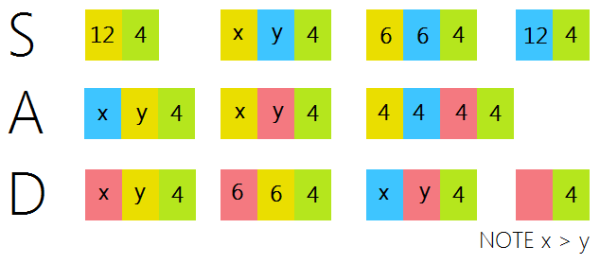
Here is a question. What insanely hypothetical solution/meta/card would you need to make stands and draws better or at the very least viable?
Fortunately the answer is not never, since that would defeat the purpose of those triggers. Unfortunately, people have the wrong idea about the what.
Trigger Advantage
A draw gets you a +1. By comparison, Stands give +2, Both Crits and Heals +2.5 (I find Heals slightly better though). But this is all just vacuum, no support. This actually makes it EVEN BETTER for crits and heals, since there are no cards that benefit from it. (If there is a card that gets something when you heal or get a crit, let me know). So to make draw and stands more powerful, we have to make the support cards stronger.
There is another case, Stand: when the opponent is at five damage in either 2 cards checked Draw: when damaged once when you have less damage than them.
NOTE: Criticals are actually obscenely powerful. If stands or Draws generate that much advantage it’ll also be unfair. So anything I say to make the trigger “inferior” is actually a good point: balanced by extra restrictions, higher cost, or non-existent. I would rather prefer an advantage of +2.
Stand by me
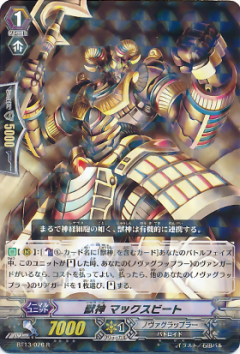
It is easy to see that stands have it better off then draws. they have the benefit of twin drive and a situation that happens most games. There is only one problem. Getting there. See, if you run stands, you must have fewer crits and hence, a slower damage tempo. Stands drain the hand, but they lack the means to kill an opponent. Tempo is a big thing: You waste more cards the closer you are to death. Since criticals send them off the edge quickly, they ALSO drain an opponent’s hand. So criticals will increase in pressure, cards drained and damage, until they hit 5. Isn’t it too bad they could not be converted into a pseudo-stand instead? (There used to be a link issue here, but after a bit of tweaking it is now fixed)
To beat criticals, you need to meet the minimum +2.5 requirement. Let’s see where this plus comes from one plus comes from the extra stage generated from the power boost. the other is the actual standing part. Assuming that the stood card can now attack something the opponent uses another card to stop it. But we need more than a +2. That is where supports like Max Beat come in. They take the stand and a cost, and generate a plus. In fact, max beat increases the advantage to +3. Oh, but there is a cost so it’s actually +2.5 instead. Still, that makes stands a viable trigger, for a cost. Given that Criticals need no such thing, it slaps max beats effort to match the crits standards ☃. Other cards with the same pluses include Flower Lei Leprechaun and Dancing Wolf.
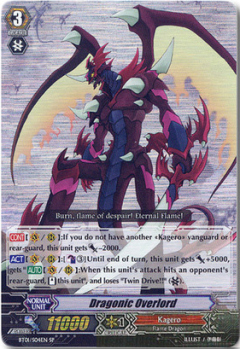
It is quite unexpected that with the large amounts of power creeping that a set one card makes stands extremely powerful: Dragonic Overlord. I dissected this card a long while back, and to sum it nicely it provides a medium-high +1 which is just perfect design wise for a CB2 unit. But it needs CB3. There is a reason for the extra counterblast, and that becomes apparent when you check a stand trigger. Suddenly, DO springs up with a devious glare and becomes absolutely terrifying. Once again it threatens a commanding lead, possibly obliterating the opponent with an overwhelming +3.5 lead. What is likelier is that your opponent saved a 2nd Perfect Guard for this occasion, forcing you to settle with +1 again. Using both the skill and checking a stand nets you a reasonable +4 (+1 for each oh DO’s attack, +2 for trigger) for a hefty one time use CB3.
But have no fear! We have a card that supports overlords ridiculous cost: Tri-Stinger Dragon! When limit breaking he unflips 2, reducing Overlord’s cost to a small CB1. Now we have significant improvement. The pure +4 is now only subjected to the conditions of the trigger check. Asserting Psy-qualia as non-existent, let’s find the expected value for a 12 Stand, 4 Heal deck: EV = 0.51*1 + 0.434*4 + 0.056*6 = +2.6. This just slightly makes Stands better then Crits. Ironically, they perform the best at 4 damage, which is pretty much the endgame already…☃
After looking through all cards in the pack, I can say the card which makes Stands better than Crits is Miracle Beauty. This should be quite obvious: You have Max beats effect and take away its restrictions and costs. Critical triggers have no support making them always stagnant. Miracle Beauty can combine with other Dimension Police to create a dangerous array of power. There is also Riot Horn which affects stands triggers just the same though harder to form magic numbers with.
Damage Tempo
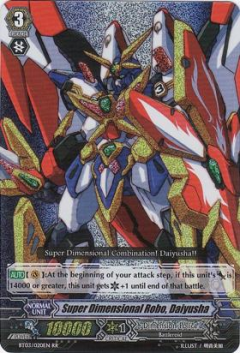
So we’ve covered support in the form of stage pressure. The two card types focus on plussing from stands, but there happens to be another way to generate advantage from stands. Utlizing the damage counter. As I’ve stated before, stand triggers are better than critical triggers once an opponent has reached 5 damage. If we can somehow force them to take as much damage tempo as criticals then stands are more useful. Problem: No card exists. There is one that is close though, which is probably the reason I wrote the article in the first place.
Buuuuut, before that we’ll pay a visit to Set3’s Super Daiyusha. This is a great unit used to force tempo, and often enough it works (the opponent probably can’t guard Daiyusha forever). Theoretically, stands work here. Nonetheless, Crits work better. The reason is that, by logic, your opponent will want to guard this amazing robot even if it means a loss in hand advantage. If you check a crit, you can allocate the trigger and force the tempo on them along with the hand drain. This can be said for any unit that gets a critical in the middle game like Phantom Blaster Overlord, Phantom Blaster Dragon, or even Majesty Lord Blaster. Although it is redundant to pair critical-boosting skills with critical triggers, this is one kind of redundancy we don’t want to remove and puts down an enormous amount of pressure. The sheer speed of these decks makes setting up a ‘counter’ or even complete a 2/2/2 field tough.
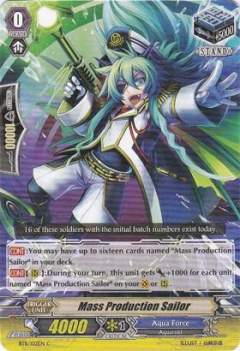
You could also try for a rush. It is a very effective tatic in of itself: A grade 1 rush means you get an additional 40000 shield due to removing grade 3’s, and more advantage by not minusing while riding. But the detail I want you to focus is that by the time you start checking stands they are way into the red zone (either past the 2DMG per turn or 5DMG per game, basically a whole subgame ahead), and because of the rushing nature you’ll most certainly have a target to stand. Some cards can even hit magic numbers by itself, and you’ll have some other rearguard you can attack regardless. The only gripe I have about running stands over critical triggers in rush builds are counter-triggers affecting the damage tempo. As it should be clear when you play rush decks, your opponent will have their asses saved many times with a trigger in the damage zone right when they need it. Hope that wasn’t a heal, because now you’ve been notched back a whole step. While criticals force out the extra touch of damage, stands do not and that makes it easier for an opponent to play damage control by being able to pick and choose the times they can take damage without a fear of criticals. Nonetheless, when they are on the ball the options to guard so early are quite limited. This makes stands viable in the most ironic kind of build available. (Only for decks that do not rush solely on 16 C, meaning they have some other gambit that allows them to move fast and prepare to withstand a break ride or two)
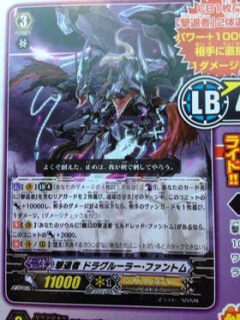
This dragon is impressive. Phantom Dragruler Dragon destroys conventional standards and opens up the notion of FORCED DAMAGE. This means that this phantom forces the damage tempo you take, and even more importantly changes an opponent’s sub-game. This is truly terrifying for defensive decks like Tachikaze and OTT, but sub-game switching is insane for anyone to take in. He is a great card to use and can go straight into a Revenger deck, but have you ever thought about pairing him with stands? Well, think about it:
- Stand triggers are better than critical triggers only when you opponent is at 5
- Stands can’t bring an opponent to 5 fast enough for the advantage to be better than criticals
- Dragruler forces an opponent to five.
Yep. This card is something that can make brilliant use of stands. This is a card with a broken effect, reverts miracle heals back into despair, and a gay defence value. The defence combined with the forced tempo makes this card paired with stands way more lethal than critical triggers, but…there is no support for a stand-variant SP.
WWWWWWWWWWWHHHHHHHHHHHHHHHHHHHHHYYYYYYYYYYYYYYYYYYYYYYYYYY????????????!?!!??
[CONT](V): Get’s retarded defense if you have a card named “Illusionary Revenger, Mordred Phantom” in your soul
[CONT](V/R): LordConsidering the Limit Break skill only. We have three costs/conditions and two outcomes. Putting that into a table:{10k + DMG} – {LB4 + CB1 + retire 2} 2 + DMG – 1 – 0.5 – 2 = ?So how much is a damage? Well, during battle 1.5 card ~= 1 Damage. We can also look at it like this: Ergodiel {Heal} – {CB1 + Persona} = -0.5, Healing is +2 but that ignores triggers.
While taking damage you have 16/49 to recover with something, 4/49 being a heal.
So a critical takes a +2 down to ~+1.5. 2 + 1.5 – 1 – 0.5 – 2 = 0 Dead nothing in terms of cost:advantage. If you remove LB as a cost then you get off with a +1.
But there is an amazing array of support. Nemain, Darkside, and Swordbreaker convert the cost into CB2 retire 1, which gives you a net +0.5. Mana and Caar do even better making it CB1 retire 1, giving you a +1 in advantage. Or remove useless gr3 rearguards and dead boosters for a fresh array of units; like Dorint + BDR so the pluses stack. Mordred – its base – somewhat synchronizes. It provides a buff of power and pops out a unit to kill. In addition the LB fits within your LB so you’ve cut down on costs. Lastly, you can chain Mordred>Mana>Darkside>Trig, a horrifying +4 advantage on its own without the addition of Dragruler. But perhaps the best thing about Dundeger is the power boost. This assures the fighter that they don’t need a vanguard booster, kinda like Alfred. During the limit break stage you can neglect a booster:
1) Prevents it from being targeted by rearguard haters and
2) opens the spot next turn for more random call shenanigans and a pseudo-plus card advantage.All in all, Dragruler is really powerful and has amazing support.
Dreadfully Doomed Draws
So after all that about standing, you might expect an equally hefty section concerning Draw Triggers. Unfortunately, that is not the case. Draws only can be put to use in two different card effects:
- When you draw a card …
- [Discard 1 card from your hand] …
For the first scenario, there is exactly one card that does that. Is it good? Nope.
For the second scenario, there are now a lot. Recall the advantage a critical trigger gets you: +2.5. This means, a discard must provide you with 2.5 units of advantage to be equal. That is kinda like saying discarding two cards can nuke the entire field, though that is way too much for one card to be capable of doing☃. Instead, we can take the advantage and chunk it based on the normal draw rate, which is 3. So you can say, a discard can provide (2.5-1)/3 or 1.5 units. That’s around 15000 Power, top calling three units, Retire 1 then unflip 1. Only then can there be a use for draws.
Drawing a Conclusion
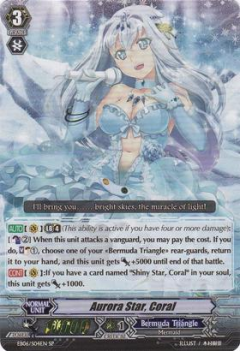
But it’s not over yet; The stands and draws have one last thing to say. If you ever have a something that is a wobbly mess of units, engines and form, a rainbow trigger is an interesting invention. Most non-optimized decks do make good use of both stands and draws for the pure lack of direction. They have a general benefit from everything as they try to focus on card, hand and damage advantage, which is to say they aren’t focused at any given one! Pictured on the right is such a build. You can’t go wrong with any trigger lineup, in any of the tiers. That’s because it is doomed to failure anyways. Have fun with your casual competitive tourneys!
